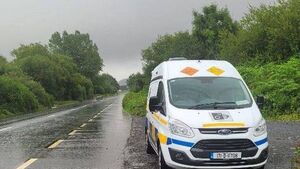'Excessive number' of speeding prosecutions on Kildare/Laois border

A GoSafe van in operation on a local road. File image for illustration
MORE than 30 speeding cases that were recorded on the Kildare/Laois border
were dismissed by Judge Andrew Cody, who said it would be "unjust" to convict drivers of exceeding the speed limit on a road that accounted for more fines in 2022 than all of Co Kilkenny.
Judge Cody said that, for the past two years, he had been “very concerned about the excessive number of prosecutions by GoSafe” for exceeding the speed limit in the townland of Clogheen, near the Laois/Kildare border.
The judge also noted that the 60kph zone at Clogheen, which is just 700 metres long, accounted for more fines in 2022 than all of Leitrim, Clare and Longford combined.
Dismissing 32 speeding prosecutions brought by GoSafe at a recent sitting of Portlaoise District Court, the consortium that operates speed vans around the country, Judge Cody said the short stretch of road at Clogheen was so lucrative that it accounted for €108,240 in fines issued by GoSafe in 2022.
Judge Cody said: “The question has to be asked, how can a 700 metre of roadway have the same level of prosecutions as all of Kilkenny, Louth or Mayo and over five times for the entire county of Leitrim?”
At the court hearing shortly before Christmas, the judge dismissed 32 cases where the speed was below 80kph in the 60kph zone at Clogheen. Fines were issued to six motorists who were travelling at above 80kph. A total of 38 GoSafe cases had been adjourned from earlier hearings for the judge to consider his ruling.
In a lengthy written judgement, setting out his reasons for dismissing 32 GoSafe prosecutions, Judge Cody said:
‘The townland of Clogheen is just inside the Kildare border and one of a small number of townlands outside the county of Laois that is part of the District Court area of Portlaoise.
The District Court area comprises the county of Laois gaining a small number of townlands from Kildare around Monasterevin, Offaly around Portarlington and losing a few to Kildare around Ballylinan, and Vicarstown and to Tipperary around Borris-in-Ossory.
Townlands.ie lists 1,111 townlands in County Laois and it is fair to assume that a similar number of townlands are in the District Court area of Portlaoise. There are approximately 2,465km of public roads throughout Laois. Of that total, 65km are motorways, 100km are national secondary roads, 350km are regional roads and the remaining 1,950km are local roads. The 60km speed zone in the townland of Clogheen is 700m long and represents 0.003% of the road network of this District Court area.
For the past two years, I have been very concerned about the excessive number of prosecutions by GoSafe for exceeding the speed limit in the townland of Clogheen.
The townland of Clogheen is south of the town of Monasterevin and goes from the Hazel Hotel toward Ballybrittas with the 60km zone covering 700m of the R445 south of the Clogheen crossroads.
The road is approximately 12m wide in total with a large margin at each side. Along the 700m there is one farmhouse and one house, and one can admire the open countryside with horses, sheep and cattle grazing in the fields.
One has to wonder why one townland out of 1,111,in County Laois and 700m of roadway representing 0.003% of the road network has so many prosecutions.
To put the number of prosecutions on this 700m stretch of road in context, for Clogheen, which is in Kildare, fines in 2022 amounted to €108,240 and the remainder of the District, the entire County of Laois was €53,320. Thus, within this District Court Area more than 2 out of every three euros fined for speeding occurs on a 700m stretch of roadway representing 0.003% of the road network.
The fines generated in 2022 from Clogheen exceeds those earned from County Leitrim (€22,920), County Longford (€23,600), County Clare (€53,560), County Laois (€53,320) County Sligo (€68,160) County Roscommon (€90,440) and Kilkenny (€98,440). In fact, it earned more than the three lowest Counties combined and was similar to Louth (€112,160), and Mayo (€113,280) The question has to be asked how can a 700m of Roadway have the same level of prosecutions as all of Kilkenny, Louth or Mayo and over five times for the entire County of Leitrim?
No other SpeedZone in County Laois appears in the top 50 for 2022 where the lowest amount levied is just over €38,000. Clogheen appears at number 11 nationally, with Ballynafoil Galway taking the honours at €326,240.
The setting of speed limits happens at two levels. The Minister for Transport sets general default maximum speed limits known as “ordinary speed-limits” for different classes of road as defined by the Minister under statute law.
On a more local basis local authorities can set speed limits which depart from the default national standards, and these are known as special speed limits. The local authority is required to review the Special Speed Limits in force in the county on a five-yearly basis.
The Department of Transport guidelines for setting speed limits in Ireland gives guidance to local authorities on appropriate speed limits depending on road conditions. It says and I quote: “These roads are wide two-lane roads with hard shoulders and have an overall minimum paved width of 8m, have grass verges and are characterised as being ‘improved’. For these roads the appropriate speed limit should normally be 100 km/h.” This 700m 60kph zone at Clogheen is exactly such a road and drivers could be forgiven for believing they are travelling in a 100kph zone.
In the summer of 2021 Kildare County Council, in exercise of the powers conferred on it by Section 9, subsection (4), of the Road Traffic Act, 2004 gave notice of its proposal to make Special Speed Limit Bye-Laws in respect of public roads within the administrative area of the County of Kildare.
Mr Donal Hodgins Senior Engineer in the Roads and Transport Department of Kildare County Council recommended on the 26th of July 2021 that both the 60kph and 80kph zones in Clogheen be increased to 100kph.
Unfortunately, despite the passage of 3 ½ years the speed limits have yet to be reviewed by Kildare County Council.
The Current Speed limits were set by Kildare County Council in 2011 and should have been reviewed twice by now, once in 2016, and again in 2021.The setting of this or any speed limit is not for this Court, and it is entirely a matter for Kildare County Council, in their wisdom, to set these speed limits but I would ask that they review this speed limit as a matter of urgency. There is no doubt in my mind that Kildare County Council are in dereliction of their duties to the citizens of Kildare, Laois and Offaly and the entire State by failing to review the speed limits in accordance with their duty.
This Court has been convicting people here for the last two years of a criminal offence for travelling at speeds as low as 67kph in this speed zone , adding five penalty points to their license. 67kph on this stretch of road is travelling at a speed that according to the Council engineers (tasked with such an assessment) is safe and in normal circumstances poses no danger of any description to anyone else using that road.
Why then is there such a wholly disproportionate number of speeding prosecutions by GoSafe against motorists driving through the townland of Clogheen?
The answer in my view lies in the fact that we all travel at a speed we perceive to be safe, but unfortunately some people’s perception of safe far exceeds what is actually safe and for this reason we have speed limits.
While traveling on roads we should watch out for speed signs, but we don’t always notice them or if we do notice them, we do not absorb the speed limits to apply. In deciding what speed is safe we rely on our perception of the road conditions. Responsible drivers in my view judge their speed, safety, and appropriateness almost entirely by information that they can see.
Incompatibility between the sign posted speed limit and the road characteristics can cause drivers to exceed the speed limit, because they perceive themselves to be travelling at a speed which is safe, and in the case of the townland of Clogheen, in many instances, it is safe.
One would expect prosecutions for speeding should be spread out throughout the District in a fairly even manner representing an even-handed approach to speed and safety enforcement, but that has not happened. While I accept that the townland of Clogheen has historically been the location of fatalities and this should be one of the factors to be taken into account, in determining the location of speed checks, I have come to the conclusion that the huge number of prosecutions by GoSafe for the 60kph zone in Clogheen has absolutely nothing to do with criminality and little to do with road safety and are driven not by safety but by targets, statistics and finance.
Prosecutions that are driven by targets, statistics and finance have no place in this Court and bring the administration of Justice into disrepute. I have come to the conclusion that GoSafe deliberately targeted an unjust speed zone in the townland of Clogheen where there were rich pickings and as the saying goes they were “shooting fish in a barrel”.
In taking an oath of office under Article 34 of the Constitution I duty bound myself to uphold the laws of the land, however, I am also cognisant of the Supreme Court’s decision in The People (DPP) v Casey, [2019] IESC 7 when Charleton J said “The Constitution, at Article 34.1, in requiring justice to ‘be administered in courts established by law by judges appointed in the manner provided for in this Constitution’ does more than lay down a procedural framework or merely set up a structure for the system of civil and criminal litigation.
Rather, it devolves ultimate responsibility onto judges to ensure that what occurs in legal actions heard before the courts is the pursuit of justice through a diligent, reasoned, detached and proportionate search for the truth. Article 38.1, in requiring criminal offences to be tried in ‘due course of law’, amounts to an imperative that courts pursue the aim of justice.
In responding to a criminal charge with an account which asserts that while there has been a breach of the law, an outcome of a guilty verdict would amount to an affront to justice, an accused both admits the commission of an offence and also seeks the application of constitutional fairness … That [plea] arises because in some important respect, and unrelated to the elements of the offence, or to the capacity of the prosecution to adduce evidence in relation to such elements, the prosecution, or continued prosecution, of the charge would fall short of the constitutional administration of justice.” These are my views generally and I will consider each of the speeding summonses today on their own merits considering what I have already said.
Finally, I wish to make it clear that the foregoing comments are not in any way reflective of the rank and file members of An Garda Síochána, particularly those in the Road Traffic Unit here in Portlaoise. Until recently the County of Laois was the only Country without a road fatality this year, and very regrettably a lady lost her life on the roads in Laois recently. Despite this Laois still has the lowest number of fatalities in the State this year and that is testament to the good work and dedication of An Garda Siochána in Laois and the Road Traffic Unit in particular, who continue to detect and prosecute cases in a fair and proportionate manner based on the need to keep all of our citizens safe on our roads.’





